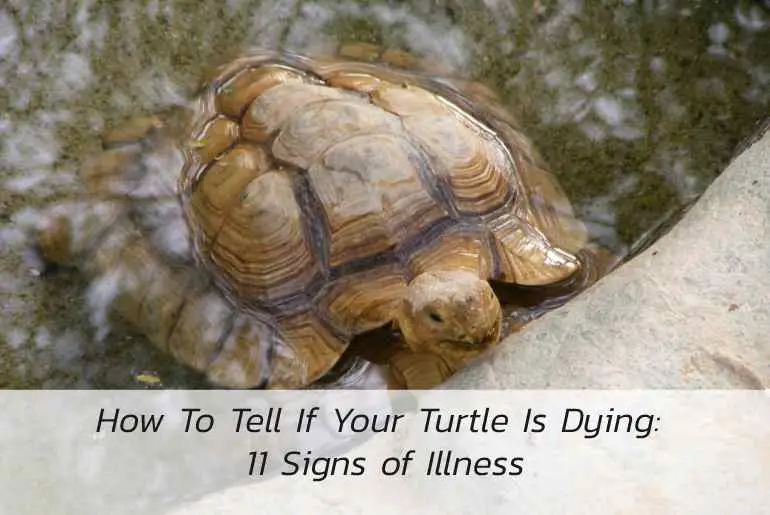If you’re a turtle owner, it’s important to be able to tell when your pet is healthy and when it’s not. Unfortunately, many turtles die each year because their owners don’t recognize the signs of illness. In this blog post, we’ll discuss 11 signs that your turtle might be sick. We’ll also provide tips on how to prevent illness in turtles and what to do if you think your turtle might be dying. Stay safe and healthy, turtles friends!
It can be difficult to tell when a turtle is sick or dying. They often mask their illness very well, and by the time you realize something is wrong, it may be too late.
In this blog post, we will discuss 11 signs of illness in turtles. We will also provide some tips on how to prevent your turtle from getting sick in the first place and what to do if you think your turtle might be dying.
How To Tell If Your Turtle Is Dying? 11 Tell-Tale Signs
There are several signs that can indicate that your turtle is not doing well. If you notice any of the following, it’s important to take your turtle to the vet as soon as possible:
Lethargy
As any turtle owner knows, these creatures require a lot of care and attention. One of the most important things to monitor is their activity level. A healthy turtle will swim and bask routinely. So, when it stops upholding this regime, it often means that your turtle has no energy to do so.
So, if you notice that your turtle is being more lethargic than usual, it’s important to take action. The first step is to check whether your turtle is resting or going through infirmities. The best way to do this is to drop the turtle’s favorite treat near it. If the turtle doesn’t show any interest in the treat, you can also try poking it gently to see if there are any signs of mobility.
If your turtle doesn’t respond to either of these stimuli, it’s likely that it is dying. While this is a difficult situation to face, it’s important to remember that turtles have a relatively short lifespan. So, while it may be hard to say goodbye, it’s important to appreciate the time you had with your loyal companion.
Foam-like Discharge From Mouth
If you notice that your turtle has thick fluids and bubbles coming out of its mouth, nose, or eyes, this is a sign that the turtle is gravely sick and in the last stages of its life. The bubbles are actually puss being discharged from an infection.
Pneumonia is a common respiratory illness in turtles that can lead to death. If your turtle is showing signs of pneumonia, such as fluid buildup and difficulty breathing, it’s important to seek veterinary care immediately.
However, even with treatment, turtles with pneumonia often do not survive. If your turtle is diagnosed with pneumonia, you may want to consider euthanasia to prevent further suffering.
Slow Breathing
A healthy turtle will fill its lungs with air to expand and contract its chest. But an unhealthy turtle does not have the vitality to intake enough oxygen. Thus, displays labored breathing.
A turtle’s eyesight starts to fail, and their heartbeat slows down as they age. When a turtle’s heart rate dips too low, they go into cardiac arrest and die.
At their final stage, turtles go into dyspnea and cannot fulfill the oxygen requirement. Their lungs won’t function properly to filter oxygen, which is why they slow down their breathing. If your turtle is breathing this way, there isn’t much time left. Dyspnea is a medical emergency, and you should take your turtle to the vet immediately.
The outlook is not good for turtles at this stage, but there are things that can be done to make your turtle more comfortable. Pain medication can help to ease your turtle’s discomfort, and supplemental oxygen can help them to breathe more easily. Ultimately, though, the decision to euthanize your turtle is a personal one that only you can make.
Unusual Feces Or Bloody Diarrhea
One of the first signs that something is wrong with your turtle is changes in their feces. If you notice that your turtle’s feces are watery, bloody, or have mucus in them, this is a sign of illness. Diarrhea can be caused by a number of things, including viral infections, bacterial infections, parasites, and even stress.
If your turtle has diarrhea, it’s important to take them to the vet as soon as possible. Diarrhea can lead to dehydration, which can be deadly for turtles. Treatment for diarrhea will vary depending on the underlying cause but may include antibiotics or other medications.
Bad Buoyancy
Turtles are reptiles, and as such, they are ectotherms. This means that they rely on the environment to regulate their body temperature. When a turtle is healthy, it will bask in the sun to warm up and then cool down in the water to cool off.
However, when a turtle is sick, it may not have the energy to warm itself up. This can lead to a condition called hypothermia, where the turtle’s body temperature drops below normal. If your turtle is basking more than usual, or if it seems cold to the touch, this is a sign that something is wrong.
Hypothermia is a medical emergency, and you should take your turtle to the vet as soon as possible. Treatment for hypothermia will vary depending on the severity of the condition but may include supplemental heat or fluids.
Shriveled Skin
As turtles age, their skin starts to thin and loses its elasticity. This process is accelerated in sick turtles. As a result, you may notice that your turtle’s skin is dry, flaky, and wrinkled.
If your turtle’s skin looks shriveled, it’s a sign that they are not getting enough moisture. This can be due to a number of things, including dehydration, kidney disease, or even just old age. If you notice that your turtle’s skin is looking shriveled, you should take them to the vet for a checkup.
Swollen Eyelids In Case Of Respiratory Illness
Turtles are susceptible to a number of respiratory illnesses, such as pneumonia and bronchitis. These illnesses can cause the tissues around the turtle’s lungs to swell up, which in turn can cause the eyelids to swell shut. If your turtle’s eyelids are swollen, it’s a sign that they are not getting enough oxygen.
If your turtle has swollen eyelids, it’s important to take them to the vet as soon as possible. Treatment for respiratory illness will vary depending on the underlying cause but may include antibiotics or supplemental oxygen.
Sunken Eyes
As turtles age, their eyes start to sink into their sockets. This is due to a loss of muscle tone and can be accelerated by illness. If your turtle’s eyes seem sunken in, it’s a sign that they are not getting enough nutrients.
If your turtle has sunken eyes, it’s important to take them to the vet for a checkup. They may need to be started on a course of vitamins or other supplements.
Rotten Shell
The shell is the turtle’s exoskeleton, and it protects its internal organs from harm. The shell is made of keratin, which is a tough but porous material.
If your turtle’s shell starts to soften or break down, it’s a sign that they are not getting enough calcium. This can be due to a number of things, including kidney disease, vitamin deficiencies, or even old age. If you notice that your turtle’s shell is softening, you should take them to the vet for a checkup.
Loss Of Appetite
A loss of appetite is one of the first signs that something is wrong with your turtle. If your turtle stops eating, it’s a sign that they are not getting the nutrients they need to stay healthy.
A loss of appetite can be due to a number of things, including illness, stress, or even old age.
Some Dying Turtles Produce Noise
As turtles near the end of their lives, they may start to produce noises such as wheezing or gasping. This is due to the weakening of their respiratory system. If you notice that your turtle is making strange noises, it’s important to take them to the vet as soon as possible.
How To Prevent Illness in Turtles?
The best way to prevent illness in turtles is to keep their environment clean and free of bacteria. This can be done by regularly cleaning their tank or pond with a disinfectant solution.
You should also avoid handling your turtle too much, as this can transfer bacteria from your hands to their shell. If you must handle them, make sure to wash your hands thoroughly before and after.
Suppose you’re thinking of getting a turtle. Congratulations! Turtles can make great pets. But there are a few things you need to know about caring for them properly.
Maintain Water Parameters
First and foremost, always maintain the recommended water parameters for turtles. This means keeping an eye on the nitrite, nitrate, and ammonia levels in the Tank and taking steps to control them if necessary.
The Temperature of The Tank
It’s also important to keep the optimum temperature in both the basking area and the water. Prolonged exposure to cold temperatures can lead to respiratory illness in turtles, so be sure to monitor the temperature closely.
Dechlorinate Tap Water/ Clean The Tank
If you’re using tap water for the tank, be sure to dechlorinate it first. Cleaning the tank at regular intervals is also important to keep it clean and free of harmful bacteria.
Monitor Weight of Turtles
Finally, remember that controlled feeding is necessary to avoid obese or underweight turtles. Monitor your turtle’s weight at fixed intervals and adjust its diet accordingly.
You might also be interested in the following articles:
- Can You Eat Turtles? Here’s What You Need to Know
- Can Turtles Eat Dog Food? The Truth About Feeding Dog Food
- Can Turtles Eat Spiders? Will Your Turtles Die?
- Do Catfish Eat Turtles? – The Complete Guide
How To Know If My Turtle Is in Brumation Or Dead?
Brumation is a state of dormancy that turtles enter when the weather starts to cool down. During brumation, turtles will slow down their metabolism and may stop eating altogether.
If you think your turtle is in brumation, it’s important to take them to the vet for a checkup. They may need to be started on a course of vitamins or other supplements.
As any turtle owner knows, these creatures are prone to going into periods of dormancy, known as brumation. During this time, they may become less active, and their metabolism will slow down. As a result, it can be difficult to tell whether your turtle is simply taking a nap or has passed away.
However, there is a simple test that you can perform at home. Just put your turtle in a container of lukewarm water. If it is still alive, the warm water will stimulate its sensory receptors and provoke some kind of response, such as urinating, defecating, or twitching its legs.
If your turtle doesn’t show any signs of life after being in the warm water for a few minutes, then it is probably dead. Of course, if you’re still not sure, you can always reach out to a nearby vet for confirmation.
Final Words
Remember, if you think something is wrong with your turtle, it’s always best to take them to the vet for a checkup. Early diagnosis and treatment can often save their lives.
Turtle care may seem daunting at first, but it’s actually quite simple once you get the hang of it. Just remember to keep an eye on their health and always consult a veterinarian if you’re unsure about something. Thanks for reading!
Related articles:






